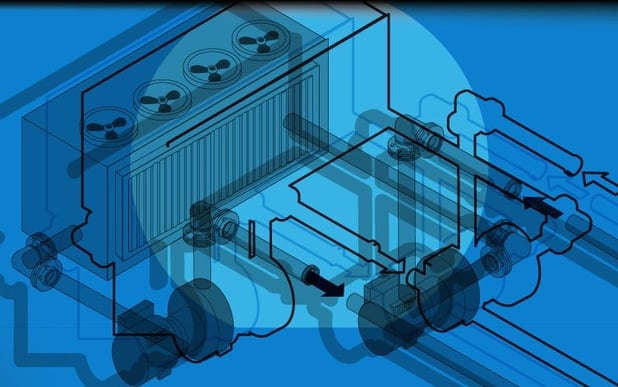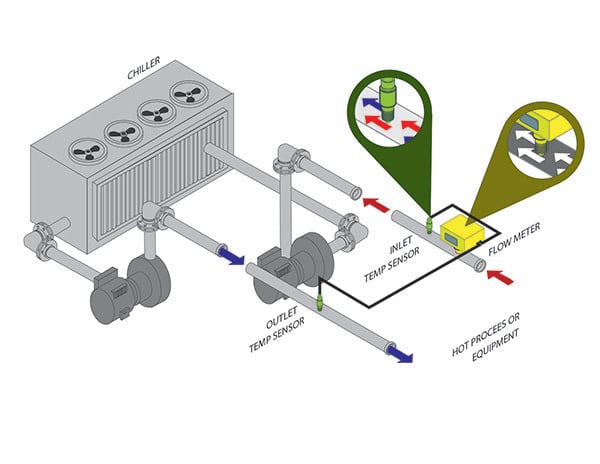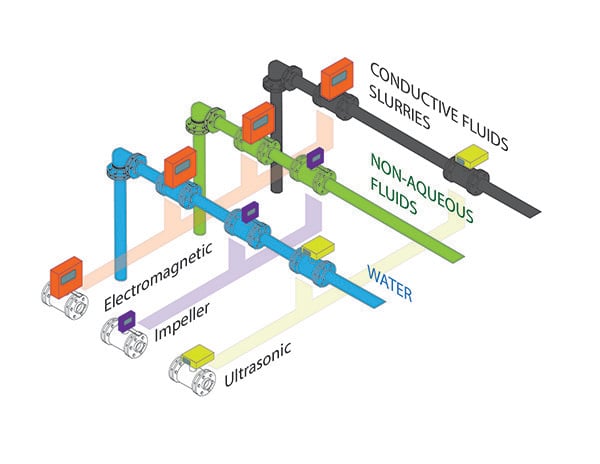Flow Monitoring in Process Cooling Applications

When most people think of industrial process cooling systems, they consider the cooling equipment like chillers, heat exchangers, or refrigerators, as well as a network of pumps and pipes to move cooling fluid through the facility. But these systems also require a number of peripheral devices to ensure that the system is performing as it should. Flow monitoring devices installed in key locations throughout the installation can help to detect inefficiencies in the chiller system. Increasing the chiller efficiency reduces facility costs, and also provides early detection of potential maintenance issues.
Importance of Flow Monitoring
Flow monitoring in process cooling systems offers several benefits. First among them is the ability to quantify the efficiency of the chiller. As much as 30 percent of the total energy consumed by an industrial facility is used by the process cooling systems, so increasing the chiller efficiency is always a worthwhile exercise. Pascual Espinoza, Technical Sales Manager, Badger Meter, explains, “Any chilled water system that utilizes variable primary and secondary loops are reducing their bottom lines with the use of flow meters since it is flow meters that help control the loop flows. Being able to control the loop flows on an as-needed basis based on energy/HVAC demands helps with electricity cost savings since pumps are big users. Systems that don’t use variable flow loops use constant speed; no flow meters necessary, however, very energy inefficient.”
To calculate the chiller efficiency, use a flow meter and a pair of temperature sensors for measuring a temperature differential. Mount the flow meter and the first temperature sensor on the inlet pipe to a chiller, and the second temperature sensor on the chiller outlet (see figure 1).
 Figure 1
Figure 1
With the flow rate and temperature differential known, the efficiency is calculated using the following definitions:
- Chiller tonnage is defined as the amount of heat required to melt 1 ton of ice in 24 hours.
- 1 ton = 12000 BTU/h
- Chiller tonnage = 500 x flow rate in gpm x ∆T, where ∆T is the temperature differential between the chiller inlet and outlet
- Efficiency = kW/ton, where is kW is the electrical input in kilowatts. A lower kW/ton value indicates higher efficiency.
To improve the efficiency of the process cooling system, first calculate the initial efficiency of the chiller. Then look for ways to optimize performance. Replace weak or restrictive valves and fix leaky seals. Make sure that all equipment in the system is well maintained to avoid component failure. Then calculate the efficiency again to see how much it has increased. As long as the flow rate is kept at a constant value, there are two ways to compare efficiency: 1) compare the kW/ton values, or 2) compare the ∆T values at the chiller. Either a lower kW/ton value or a higher ∆T indicates increased efficiency.
Frequently re-calculating the chiller efficiency allows a facility manager to ensure that the cooling system is operating at peak performance all the time. Tracking this data over time allows performance trends to be identified so that managers can anticipate the needs of the cooling system and respond proactively to maintenance issues, which can become costly if neglected.
There are a few other benefits to monitoring flow in the cooling system. Most types of industrial equipment have a specified rate of flow that is needed to adequately cool the equipment. If the flow rate is inadequate, the equipment is at risk of overheating. Installing flow meters near sensitive equipment is the best way to monitor whether the equipment is being properly cooled.
Monitoring the flow rate also helps to detect leaks and failing pumps. When the flow rate drops suddenly in one section of the cooling system, it could mean that a substantial leak in the cooling fluid system has formed or that a pump has failed. Quick detection of these problems allows the facility to take steps like redirecting the flow of cooling fluid or reducing the use of heat sensitive equipment while the leak or the pump is repaired.
Integrating Flow and Energy Data into a BAS System
In many facilities, the peripheral devices are integrated into a single control system. Traditional BAS peripherals have analog outputs (e.g. 4-20 mA) that send a single data element to the controller. However, multiple data elements are required to calculate energy and efficiency, for example, kWs consumed, flow rate, and temperature differential. To transmit multiple data values to the controller, many systems use protocol transmitters. Sensors and metering devices are connected to the transmitter, which then sends the data to the control system using a building protocol language such as Modbus or BACnet. These languages are compatible with most standard building control systems and allow the collection and integration of all data required to quantify energy-related values.
Choosing the Right Flow Monitoring Device
Choosing the best flow meter for industrial process cooling systems is not as complicated as it sounds. The most important variables in this selection are the size of the pipe and the type of fluid used in the chiller system. Many flow monitoring technologies exist, such as impeller, ultrasonic, and electromagnetic models, and each type of device can be purchased for a variety of pipe sizes.
For a basic, water-cooled chiller system, a simple impeller style flow meter is usually sufficient. They are cost-effective and easy to install in almost any system, and they are compatible with a wide range of pipe sizes. Simply install the device so that the impeller is in line with the direction of water flow. Many impeller-style meters are available with temperature probes that connect directly to the meter, allowing quick calculation of the chiller tonnage and the overall efficiency.
Ultrasonic flow meters are mounted on the outside of the pipe. Transducers are mounted opposite each other, and ultrasonic waves that pass between the transducers are used to measure the flow rate. Ultrasonic meters are useful in applications that involve fluids other than water, since some chemicals can damage impeller units. Ultrasonic meters can also measure flow in either direction.
Electromagnetic flow devices measure flow in conductive fluids. When installed, the magnetic coils in the meter generate a magnetic field around the pipe. An electrode is inserted into the pipe to measure the voltage of the fluid. Flow rate is calculated as a function of this voltage. Electromagnetic flow meters are useful for slurries and other fluids that contain solids, which would foul an impeller or disrupt an ultrasonic transducer.
 Figure 2
Figure 2
Many cooling system designers decide to use high accuracy flow devices to ensure that all calculated values represent the system as closely as possible. While high accuracy in measurements is always a good idea, in process cooling applications the reality is that repeatability is more important than accuracy. “Don’t over-focus on flow and temperature accuracy. That can lead to overly-expensive solutions. Repeatability is more important. Time based comparisons provide the information that is valuable and the basis for measurement and efficiency,” states Troy Wecker, Product Manager at Veris Industries, a leading seller of flow monitoring devices. When using the flow rate in efficiency calculations, if the flow rate is inexact, but consistent, the tonnage values can still be compared, and changes in efficiency can still be tracked.
Improve the Bottom Line
With all the energy consumed by a process cooling system, improvements to efficiency have a direct impact on a facility’s bottom line. Flow monitoring is a critical variable in efficiency calculations. To best manage your building’s energy consumption, more information is always better, so invest in good building peripherals, such as durable, high quality flow metering devices.





